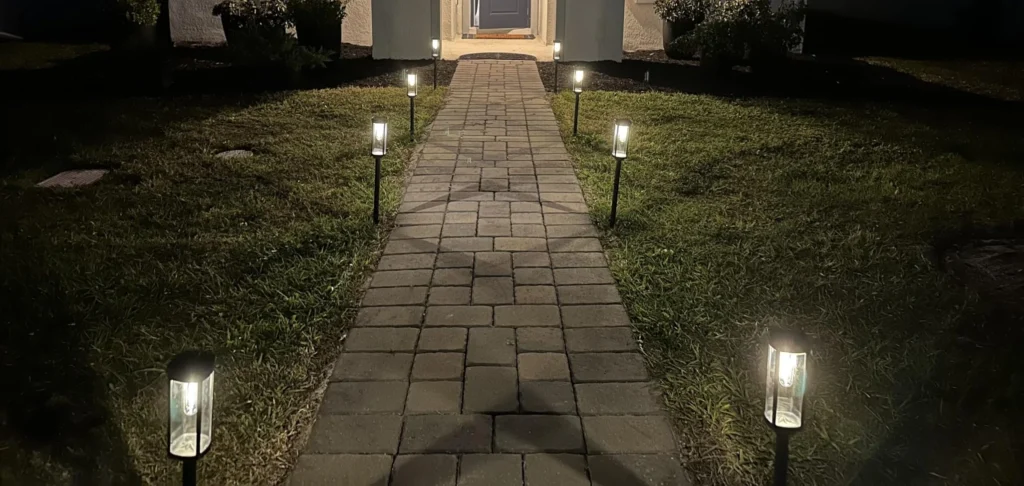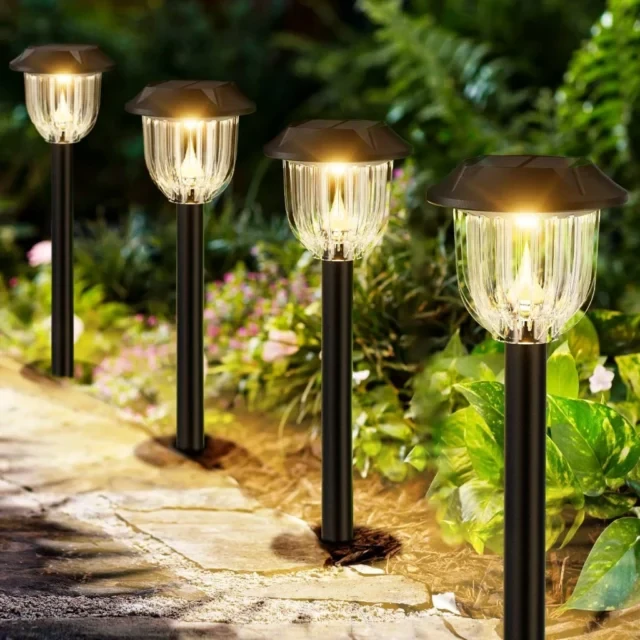The U.S. solar landscape lighting market is positioned for growth from 2025 to 2030, driven by demand for sustainable, energy-efficient outdoor lighting and technological advancements in photovoltaic (PV) systems. However, recent U.S. tariffs, particularly those targeting solar components from China and Southeast Asia, introduce significant challenges and opportunities. This report analyzes the market’s trajectory, incorporating U.S.-specific trends, the impact of 2025 tariffs, stock market implications, and investment prospects, while drawing insights from China’s dominant role in global solar lawn lighting production.
Market Overview
Solar landscape lighting, including solar lawn lights, path lights, and floodlights, utilizes crystalline silicon solar cells, LED light sources, and intelligent controllers to provide eco-friendly illumination. These products are valued for their energy savings, ease of installation, and aesthetic appeal, dominating over 50% of the U.S. solar lighting market, akin to China’s industry trends. The global solar lighting market, valued at USD 8.1 billion in 2022, is projected to reach USD 24.4 billion by 2030, with a CAGR of 14.8%. The U.S., holding ~35% of North America’s landscape lighting market, is expected to grow at a CAGR of 7.8% through 2030, driven by residential and commercial adoption.

Key Market Drivers
- Sustainability and Aesthetics: U.S. consumers, like those in China, prioritize eco-friendly and decorative lighting for gardens and patios, boosting solar lawn light demand.
- Urban Green Space Expansion: With U.S. urban green areas growing (e.g., 40.47 m² per capita globally in 2020), the potential market for solar lawn lights could exceed 100 million units by 2030, mirroring China’s 5.4 billion-unit estimate.
- Technological Advancements: Monocrystalline panels, lithium-ion batteries, and smart controllers enhance performance, addressing cloudy-day charging concerns noted in both markets.
- Seasonal Demand: U.S. holiday seasons (e.g., Christmas, Halloween) drive fast-moving consumer goods (FMCG) trends, similar to China’s festival-driven sales.
Market Challenges
- High Initial Costs: Quality solar lights cost USD 20–100, a barrier for some consumers.
- Cloudy Weather Limitations: Battery storage constraints in low-sunlight areas require hybrid solutions.
- Lack of Standards: As in China, the U.S. lacks unified solar lawn light standards, leading to quality variability.
Impact of 2025 U.S. Tariffs
Recent U.S. tariffs, particularly under the Trump administration, significantly affect the solar landscape lighting market, given China’s 90% share of global production and Southeast Asia’s role as a key supplier. Below is an analysis of tariff impacts, informed by recent developments:
Tariff Overview
- Section 301 Tariffs (China): In 2024, tariffs on Chinese solar cells, wafers, and polysilicon doubled to 50%, with some components facing up to 145% in 2025. Posts on X highlight extreme tariffs (up to 3,403.96%) on Southeast Asian imports linked to Chinese production, effective April 2025, targeting circumvention via countries like Cambodia, Malaysia, Thailand, and Vietnam.
- Reciprocal Tariffs (Global): A 10% tariff applies to most countries, with exemptions for energy products, steel, and aluminum (already under 25% tariffs). Southeast Asian countries face 32–48% tariffs, impacting 75% of U.S. solar imports.
- Antidumping/Countervailing Duties (AD/CVD): New AD/CVD investigations into Southeast Asian imports could impose duties exceeding 250%, further raising costs.
Market Impacts
- Cost Increases:
- Residential Projects: Tariffs are projected to raise solar module prices by USD 0.03–0.15 per watt, increasing residential solar lawn light costs by 10–20%. For a USD 50 light, this could mean a USD 5–10 price hike.
- Commercial Projects: Utility-scale projects face 19% higher module prices, affecting large-scale landscape lighting deployments in parks or retail spaces.
- Consumer Impact: Manufacturers pass on costs, with a USD 1 tariff raising final prices by USD 1.35, potentially slowing adoption among price-sensitive consumers.
- Supply Chain Disruptions:
- Southeast Asia supplies 77% of U.S. solar panels. High tariffs on these imports, combined with China’s 145% tariff, strain supply chains, risking project delays.
- Domestic production (e.g., Qcells in Georgia) cannot yet meet demand, with U.S. module capacity at 50 GW but upstream components like wafers and cells critically undersupplied.
- Job and Investment Losses:
- Historical tariffs (2017–2021) cost 62,000 jobs and USD 19 billion in investment. New tariffs could reduce 2025 installations from 35–40 GW to 20–25 GW, impacting installation jobs more than manufacturing gains.
- Each manufacturing job gained costs 31 installation jobs, with installation’s economic impact four times greater.
- Retaliatory Tariffs:
- Canada and Mexico, key aluminum suppliers for lighting fixtures, may impose counter-tariffs on U.S. electrical components, raising costs for smart solar lights.
Mitigating Strategies
- Diversified Sourcing: Companies like Inv examined by Reuters have secured domestic suppliers (e.g., Qcells) or stockpiled 50 GW of panels to buffer tariff impacts.
- Domestic Manufacturing: Inflation Reduction Act (IRA) incentives, offering 10% bonus tax credits for U.S.-made panels, encourage firms like First Solar and Qcells to expand. However, upstream supply gaps persist.
- Consumer Strategies: Homeowners can lock in pre-tariff prices by contracting now, as some installers plan price hikes from May 2025.
Market Trends and Forecast (2025–2030)
Market Size
The U.S. solar landscape lighting market is projected to reach USD 5.6 billion by 2032, with a CAGR of 7.0%. Tariffs may temper short-term growth, reducing 2025 installations, but long-term demand remains strong due to:
- Residential Growth: A 10.1% CAGR, driven by outdoor living trends and security needs.
- Commercial Applications: A 9.4% CAGR, with retail and hospitality adopting solar lights for cost savings and aesthetics.
- Market Capacity: With urban green spaces expanding, the U.S. could support over 100 million solar lawn lights by 2030, assuming one light per 25 m².
Regional Dynamics
- California: Leads with solar incentives and urban projects, though tariff-driven cost hikes may slow adoption.
- Texas: Rapid urbanization and 4 GW of solar capacity additions by 2030 support growth, despite tariff pressures.
- Pacific Northwest: Hybrid systems mitigate cloudy weather, aligning with China’s solutions for low-light regions.
- Northeast: Seasonal demand for decorative lights mirrors China’s FMCG trends, but tariffs may raise prices by 15–25%.
Technological Trends
- Smart Lighting: IoT-enabled lights with motion sensors gain traction, enhancing energy efficiency.
- All-in-One Designs: Integrated units simplify installation, a trend also prominent in China.
- Bifacial Panels: Improve charging efficiency in low-light conditions, addressing tariff-driven cost pressures.
Stock Market Analysis
Key Players
- Signify Holding (Euronext: LIGHT):
- Offers Philips Solar Path Lights; <20% of imports from China, reducing tariff exposure.
- Stock grew 5% in 2024; projected 5–7% annual return through 2030 due to diversified supply chains.
- Outlook: Stable for conservative investors.
- Acuity Brands, Inc. (NYSE: AYI):
- Expanding into solar landscape lighting; 50% revenue from Mexico faces 25% tariffs.
- Stock up 10% in 2024; 4–6% CAGR projected.
- Outlook: Growth-oriented, but monitor Mexico tariff risks.
- SunPower Corporation (NASDAQ: SPWR):
- Supplies PV panels for lighting; volatile due to tariff uncertainties.
- 8–10% CAGR projected if 50 GW capacity expansion succeeds.
- Outlook: High-risk, high-reward.
- Clear Blue Technologies (TSXV: CBLU):
- Focuses on off-grid solar lighting; 15–20% growth in 2024.
- Outlook: Speculative, ideal for smart city exposure.
Market Trends
- LED Market Synergy: The U.S. LED lighting market, tied to solar, reaches USD 11.06 billion by 2030 (CAGR 4.1%), supporting solar lighting stocks.
- Tariff Volatility: Tariffs on Chinese (145%) and Southeast Asian (32–48%) components raise costs, impacting margins.
- IRA Incentives: Domestic manufacturing credits bolster firms like Qcells, but tariff costs may offset gains.
Investment Recommendations
- Conservative: Allocate 20–30% to Signify/Acuity Brands for stability.
- Growth: 10–15% to SunPower, monitoring tariff policies.
- Speculative: 5–10% to Clear Blue for high-growth potential.
- Long-Term: Tariffs may slow growth, but sustainability trends ensure 5–10-year viability.
Cost-Effectiveness
- Savings: A solar lawn light saves USD 10–20/year (5 kWh/month at USD 0.15/kWh). Ten lights save USD 100–200 annually, with 2–5-year payback for USD 20–50 units.
- Tariff Impact: A 10–20% price increase (USD 5–10 per light) extends payback by 6–12 months.
- Regional Viability:
- Sunny Areas (California, Texas): 80–90% cost reductions vs. grid lighting.
- Cloudy Areas (Pacific Northwest): Hybrid systems yield 60–70% savings.
- Commercial ROI: Businesses achieve 3–7-year ROI, despite tariff-driven costs.
Recommendations
- Consumers: Select monocrystalline panels and LiFePO4 batteries; lock in pre-tariff prices. Brands like Solareye (USD 20–50) are reliable.
- Manufacturers: Invest in domestic production and smart designs to offset tariffs; target seasonal FMCG markets.
- Investors: Focus on firms with U.S. supply chains; monitor IRA policy changes.
- Policymakers: Establish solar lighting standards; extend IRA credits to counter tariff impacts.
Conclusion
The U.S. solar landscape lighting market, projected at USD 5.6 billion by 2032, faces short-term challenges from 2025 tariffs (e.g., 145% on China, 32–48% on Southeast Asia), raising costs by 10–20% and risking project delays. However, long-term growth is robust, driven by sustainability, technological advancements, and seasonal demand. Strategic sourcing, domestic manufacturing, and policy support can mitigate tariff impacts, ensuring the market’s alignment with global trends seen in China’s industry.
References:
- Allied Market Research. (2023). Solar Landscape Lighting Market.
- Grand View Research. (2024). Outdoor Lighting Market.
- SEIA. (2019). Solar Tariff Impacts.
- pv magazine. (2025). Trump Tariffs Impact.
- Reuters. (2024). U.S. Solar Market.
- MOST Policy Initiative. (2025). Solar Tariffs.
- Solar.com. (2025). Tariff Impacts.
- EnergySage. (2025). Trump Tariffs.

Comments